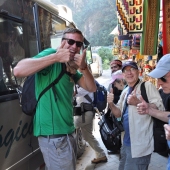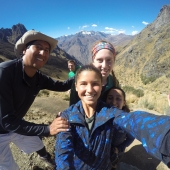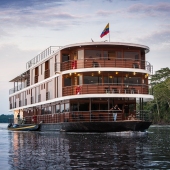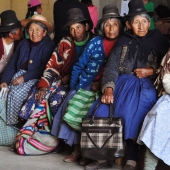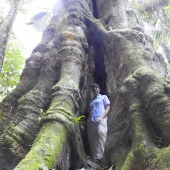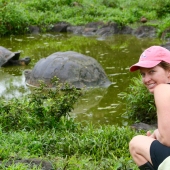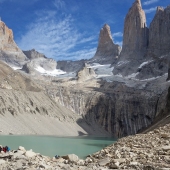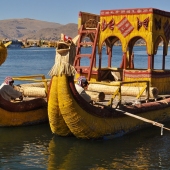
This is What Altitude Sickness Feels Like
The first time I went to Cusco, Peru with a group of high school students, let's say the altitude kicked my butt. Like virtually all travelers going to Machu Picchu, I traveled by air from sea level in Lima, Peru for 1 hour / 20 minutes to Cusco, Peru 11,000 feet / 3440 meters.
But that was not nearly as bad as the time I flew from sea level to 12,500 ft / 3810 meters in 2 hours to Juliaca, Peru, situated in the highlands not far from Lake Titicaca. Just in case I doubted my ability to adjust quickly (or ever) to high altitude, I traveled to an even higher destination. I flew from Miami to Bogota, Colombia and continued immediately to El Alto Airport in La Paz, Bolivia, at a whopping 13,615 feet / 4060 meters.
Although I'm not an altitude expert or a trained mountaineer, I've reluctantly had lots of experiences with exposure to higher altitudes in South America. I've never had the luxury of adjusting slowly to higher altitudes. I've always flown from sea level to arrive at high altitude. Mountaineers and climbers learn a "formula" for adjusting to high altitude. They go up and then down, then up higher and down over a period of several days or weeks. No one in their right mind would intentionally try to skip the steps necessary to acclimatize to high altitude. But that's what everyone who travels to Machu Picchu in Peru, or La Paz, in Bolivia, has to do.
The first thing I would notice is pressure in my head. It felt like I had a tight turban wrapped around my scull. The sensation compression surrounded my cranium and I always had a throbbing headache. There was an intense dull ache in the front region of my head. If you can imagine a sinus headache on steroids, you'll get the idea.
My ears did not hurt but sounds and voices were a little bit muffled, or perhaps filtered is a better description of the auditory sensations I experienced. Sounds were different. They seemed far away.
I would notice a feeling of breathlessness when going up an incline of any kind, or even walking briskly. I wanted to breath deeply, but I couldn't "feel" the air moving into my lungs. My mouth was open and sucking air but nothing was happening. I couldn't get the satisfaction of having the sensation that my lungs were expanding with oxygen. This was particularly noticeable when I hiked higher than 13,000 ft. even after I was officially "acclimatized."
Insomnia is a common problem with AS and I avoided drinking coffee and coca leaf tea in the afternoon or evening. Which is a practice I follow at home. I don't drink coffee after 12 noon generally. Fortunately, travelers from the US don't have huge changes in time zones when traveling to South America. Jet lag from time zone changes is one less factor to disrupt the potential for a sound night's slumber. I often woke up at least once a night when it felt like my breathing was not synchronized. It's like I was trying to breath in and out at the same time. I would breath intentionally for a minute or so, then go back to sleep.
When I first arrived at altitude, I tried not to look at bright sunlight which is tricky when you're closer to the most glaring celestial body in the solar system! It's interesting because I didnt necessarily feel the "heat" of being in bright sunlight, but my eyes detected extra brilliant light penetrating my pupils. It wasn't uncomfortable. But I found myself squinting alot and I blame the bright sun for all the wrinkles around my eyes. (that's my story and I'm sticking to it.) Wearing sunglasses provided some relief, but the best thing for me was to close my eyes and sit, or preferably lay in darkness. If possible.
Nausea is considered a normal sign of altitude sickness and a small percentage of the people who experience altitude sickness will even vomit. I only experienced slight nausea and loss of appetite. Eating and drinking anything became a chore of necessity, not enjoyment. I had to remind myself that I needed to consume additional water. And I always remembered to drink at least one cup of coffee per day. Who needs "extra" headache pain from caffeine-withdraw?
Fatigue is a common problem for people suffering from altitude sickness. The act of traveling contributes to travel burnout, and I learned to plan around overnight flights, late nights, long layovers and other aspects of the 2 days of travel it took to get from the US to Cusco. I learned what works best for me.
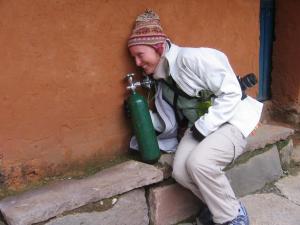
Dehydration is the devil of altitude sickness. If you don't have enough fluids in your body, your blood becomes "dry" and it doesn't flow as well. If you compare the viscosity of your blood to watery broth and a thick creamy soup, you get the idea. Moving oxygen molecules from your lungs to your extremities slows down if your blood is thick and creamy. Now you have reduced availability of oxygen molecules combined with slower delivery and that in a nutshell is the basis for our problems.
I'm claiming that my brain function was normal, although I admit I was loath to do any thinking. I didn't want people to ask me anything that required thoughtful responses. Some people apparently experience a state of mental confusion at high altitude, but I think this applies mainly to excessive high altitude, which I define as over 18,000 ft. / 5480 m.
How long does this period of adjustment last? My symptoms would usually last at least 12 hours to a full day. They would taper off slowly as I adjusted to the limited oxygen intake. My headache eventually went away and my appetite was adequate to sustain my activities. I usually always lost a little bit of weight when I traveled to altitude. (yea!) But the feeling of breathlessness never really went away entirely.
Genetics are said to be the foundation that determines how most people react to limited oxygen intake. Are age and fitness factors in how you adjust? Scientists are still trying to figure out how much of our suffering is due to the DNA we inherited and how much is actually our fault. There are lots of studies that attempt to measure people's responses to restricted oxygen intake. But it's tricky to measure in high altitude locations because you have to haul up equipment. And if you measure in controlled chambers at sea level, how accurate is the info?
I took Diamox for a while with great results. After 13 years, I no longer take anything other than 2 ibuprofen on the flight from Lima to Cusco. My suffering is barely noticeable and I accept that I will never have the capacity to move around like the locals do. I'm always sucking air on the steps and stairs in Cusco and I've learned to choose my hikes carefully. I still hike 1 Day Inca Trail and Huayna Picchu regularly.
At this stage, I feel like my body remembers how to adjust to altitude. Beginning thirteen years ago, and for several years after, I suffered when I arrived in Cusco. I learned to plan our itineraries to allow me to rest the first day. Now I can get off the plane and "get right to it" if I want to. For arrival in destinations at higher altitudes, I think I would first stop in Cusco for a couple of days, then continue to Lake Titicaca or La Paz, Bolivia.
I started my high altitude adventures at age 50 and now I'm 64 years old. I'm not afraid to go to high altitude but I am careful to allow time to acclimatize and adjust. I've been active all my life and I'm pretty fit for my age. I do scaled crossfit workouts 4-5 days a week and I don't take any medications. For over 40 years, my diet has been mainly mediterranean pescatarian with avoidance of gluten when possible and over the last year I eliminated all foods with added sweeteners. I've never smoked and I drink alcohol occasionally and sparingly.
Some people think there's an advantage to arriving in Cusco and going straight to the Sacred Valley. I disagree. For logistics reasons I prefer to stay in Cusco and suck it up.
Here's a link to my post with more info about traveling at high altitude including remedies.


